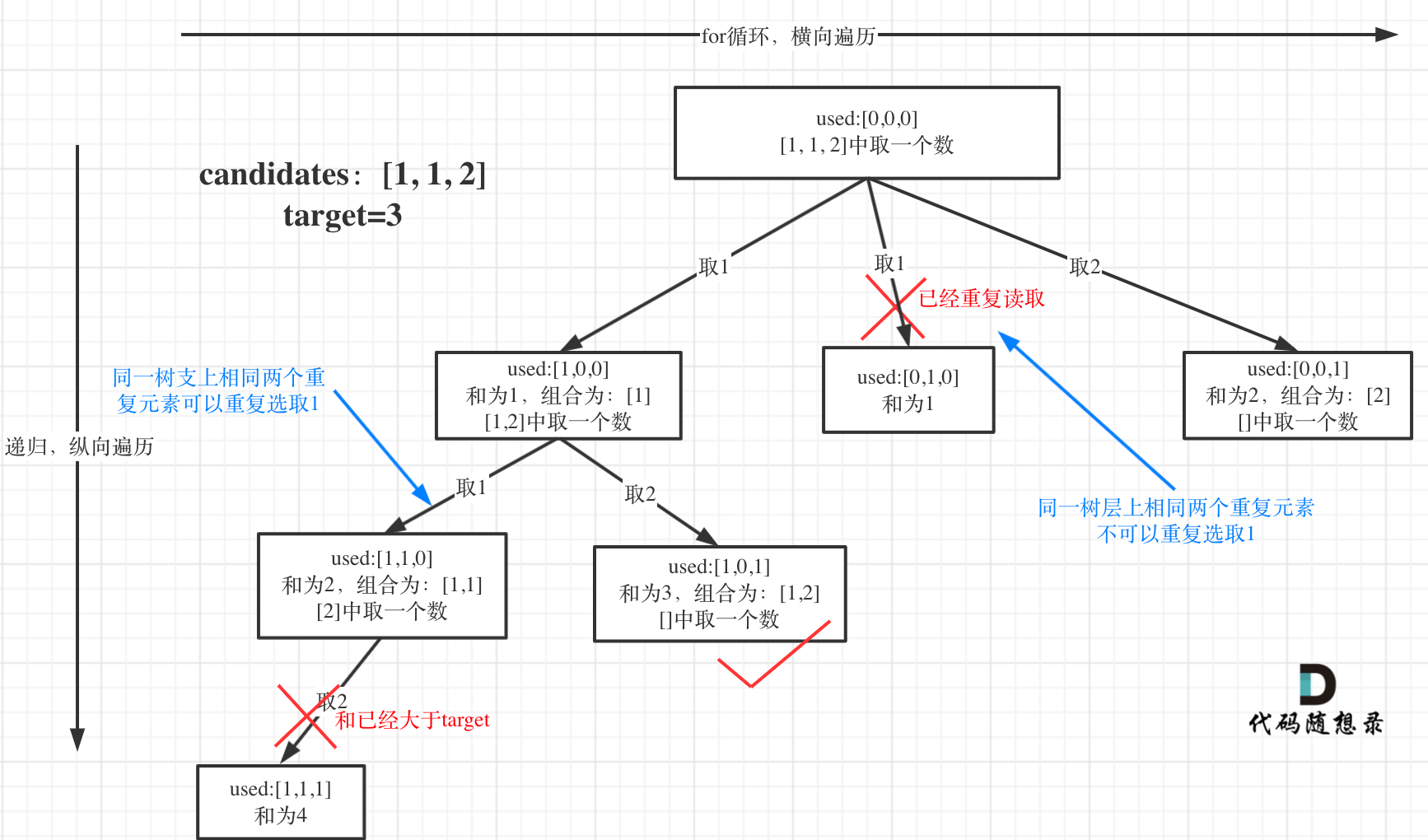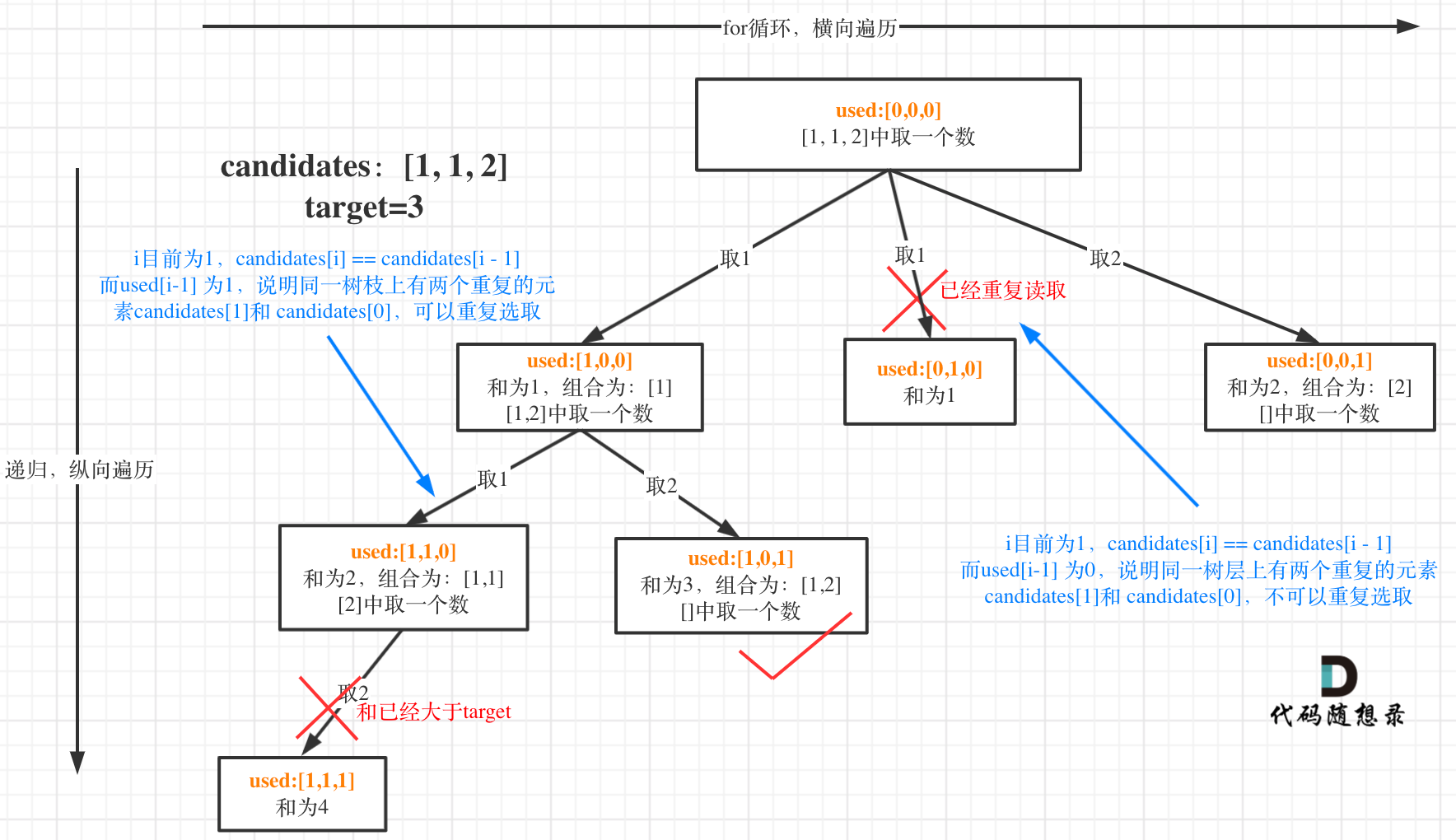LeetCode40.组合总和II
给定一个数组 candidates 和一个目标数 target ,找出 candidates 中所有可以使数字和为 target 的组合。
candidates 中的每个数字在每个组合中只能使用一次。
说明: 所有数字(包括目标数)都是正整数。解集不能包含重复的组合。
- 示例 1:
- 输入: candidates = [10,1,2,7,6,1,5], target = 8,
- 所求解集为:
[
[1, 7],
[1, 2, 5],
[2, 6],
[1, 1, 6]
]
- 示例 2:
- 输入: candidates = [2,5,2,1,2], target = 5,
- 所求解集为:
[
[1,2,2],
[5]
]
思路
这道题目和[LeetCode39. 组合总和 - Tomorrowland_D - 博客园 (cnblogs.com)]()如下区别:
- 本题candidates 中的每个数字在每个组合中只能使用一次。
- 本题数组candidates的元素是有重复的,而[LeetCode39. 组合总和 - Tomorrowland_D - 博客园 (cnblogs.com)]()是无重复元素的数组candidates
最后本题和[LeetCode39. 组合总和 - Tomorrowland_D - 博客园 (cnblogs.com)]()要求一样,但是解集不能包含重复的组合。
本题的难点在于区别2中:集合(数组candidates)有重复元素,但还不能有重复的组合。
-
我们直观的可以想到以下办法:我把所有组合求出来,再用set或者map去重,这么做很容易超时!
-
所以要在搜索的过程中就去掉重复组合。
-
这个去重为什么很难理解呢,所谓去重,其实就是使用过的元素不能重复选取。 这么一说好像很简单!
-
都知道组合问题可以抽象为树形结构,那么“使用过”在这个树形结构上是有两个维度的,一个维度是同一树枝上使用过,一个维度是同一树层上使用过。没有理解这两个层面上的“使用过” 是造成大家没有彻底理解去重的根本原因。
-
那么问题来了,我们是要同一树层上使用过,还是同一树枝上使用过呢?
-
回看一下题目,元素在同一个组合内是可以重复的,怎么重复都没事,但两个组合不能相同。
-
所以我们要去重的是同一树层上的“使用过”,同一树枝上的都是一个组合里的元素,不用去重。
-
为了理解去重我们来举一个例子,candidates = [1, 1, 2], target = 3,(方便起见candidates已经排序了)
强调一下,树层去重的话,需要对数组排序!

1.递归的参数
- 和Leetcode39组合一样,需要result存放结果,path存放单条路径
- sum来存放当前的所有和
- startindex来标志当前遍历的位置
- 还需要一个used数组来用于去重,在下面会重点介绍去重!!!
2.递归的结束条件
- 与上题一样,当sum>=targetSum就返回,如果等于,我们就收集结果
3.单层搜索的逻辑
这里与LeetCode39.组合总和最大的不同就是要去重了。
前面我们提到:要去重的是“同一树层上的使用过”,如何判断同一树层上元素(相同的元素)是否使用过了呢。
如果candidates[i] == candidates[i - 1] 并且 used[i - 1] == false,就说明:前一个树枝,使用了candidates[i - 1],也就是说同一树层使用过candidates[i - 1]。
此时for循环里就应该做continue的操作。
这块比较抽象,如图:

我在图中将used的变化用橘黄色标注上,可以看出在candidates[i] == candidates[i - 1]相同的情况下:
-
used[i - 1] == true,说明同一树枝candidates[i - 1]使用过
-
used[i - 1] == false,说明同一树层candidates[i - 1]使用过
-
为什么 used[i - 1] == false 就是同一树层呢,因为同一树层,used[i - 1] == false 才能表示,当前取的 candidates[i] 是从 candidates[i - 1] 回溯而来的。
-
而 used[i - 1] == true,说明是进入下一层递归,去下一个数,所以是树枝上,如图所示
单层递归的代码如下:
for (int i = startIndex; i < candidates.size() && sum + candidates[i] <= target; i++) {
// used[i - 1] == true,说明同一树枝candidates[i - 1]使用过
// used[i - 1] == false,说明同一树层candidates[i - 1]使用过
// 要对同一树层使用过的元素进行跳过
if (i > 0 && candidates[i] == candidates[i - 1] && used[i - 1] == false) {
continue;
}
sum += candidates[i];
path.push_back(candidates[i]);
used[i] = true;
backtracking(candidates, target, sum, i + 1, used); // 和39.组合总和的区别1:这里是i+1,每个数字在每个组合中只能使用一次
used[i] = false;
sum -= candidates[i];
path.pop_back();
}
代码:
class Solution {
public:
vector<int> path;
vector<vector<int> > result;
void backtracking(vector<int> candidates, int targetSum, int sum, int startindex, vector<bool>& used) {
if (sum >= targetSum) {
if (sum == targetSum) result.push_back(path);
return;
}
//这里的剪枝过程在组合总和中有讲到过!
for (int i = startindex; i < candidates.size() && sum + candidates[i]<=targetSum; i++) {
//如果是同一层的相同元素,就去重!也就是跳过本轮循环
// used[i - 1] == true,说明同一树枝candidates[i - 1]使用过
// used[i - 1] == false,说明同一树层candidates[i - 1]使用过
// 要对同一树层使用过的元素进行跳过
if (i > 0 && candidates[i] == candidates[i - 1] && used[i - 1] == 0) continue;
sum += candidates[i];
path.push_back(candidates[i]);
used[i] = 1;
//要注意这里是i+1,与之前讲解的组合总和不同,这里不能够选取重复的元素
backtracking(candidates, targetSum, sum, i + 1, used);
sum -= candidates[i];
path.pop_back();
//回溯的时候将之前使用过的元素置为0,标志着这是同一层的元素(树层),而不是树枝上的元素
used[i] = 0;
}
}
vector<vector<int>> combinationSum2(vector<int>& candidates, int target) {
path.clear(); result.clear();
if (candidates.size() == 0) return result;
vector<bool> used(candidates.size(), 0);
//注意这里一定要排序
sort(candidates.begin(), candidates.end());
backtracking(candidates, target, 0, 0, used);
return result;
}
};
注意:
- 本文中还多次引用到了作者代码随想录 的原图,想要深入了解的可以关注原作者,阅读原作者的文章![代码随想录 (programmercarl.com)]()